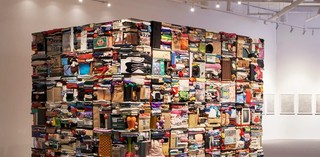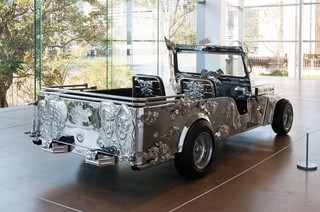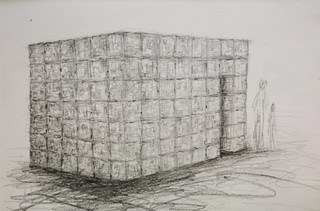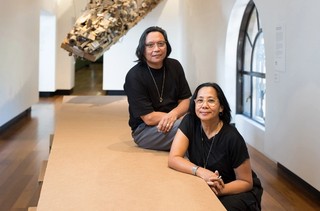2025 QAGOMA Foundation Appeal

Isabel Aquilizan, The Philippines b.1965 / Alfredo Aquilizan, The Philippines b.1962 / Address: Project Be-longing 2008 installed at PODO Museum, South Korea, 2022 / Personal belongings / 140 boxes: 50 x 50 x 50cm (each) / Proposed for the Queensland Art Gallery | Gallery of Modern Art Collection / Courtesy: Isabel and Alfredo Aquilizan / View full image
This year, the QAGOMA Foundation Appeal invites support for the acquisition of Address: Project Be‑longing 2008 by Asia Pacific Triennial alumni and ‘Wonderstruck’ exhibiting artists Isabel and Alfredo Aquilizan, whose move from the Philippines to Brisbane nearly two decades ago coloured their lives, their family and their art practice. Here, we share insights into this 'family portrait', which invites reflection on ideas of migration, belonging and home.
Watch | Isabel & Alfredo Aquilizan introduce Address: Project Be-longing
In 2006, artists Isabel and Alfredo Aquilizan moved from the Philippines to Australia with their five young children. Having previously visited Brisbane to participate in ‘Beyond the Future: The Third Asia Pacific Triennial of Contemporary Art’ in 1999, they chose to make the city their new home. Since then, their works have featured in multiple group exhibitions, including APT6 and Kids’ APT6 (2009–10) and ‘GOMA Q: Contemporary Queensland Art’ (2015). In retrospect, their 1999 installation at the Queensland Art Gallery now seems prescient: it comprised personal belongings lent to the artists by members of Brisbane’s Filipino community — items brought from the Philippines that served as tangible connections to home.
Watch | Alfredo Aquilizan introduces Project be-longing from the 3rd Asia Pacific Triennial
Watch | Isabel & Alfredo Aquilizan introduce In-flight (Project: Another Country) from the 6th Asia Pacific Triennial
In God We Trust (version 2) 2009 installed in GOMA Q: Contemporary Queensland Art

Isabel Aquilizan, The Philippines b.1965 / Alfredo Aquilizan, The Philippines b.1962 / In God We Trust (version 2) 2009 installed in GOMA Q: Contemporary Queensland Art, Gallery of Modern Art, 2015 / Courtesy: Isabel & Alfredo Aquilizan / View full image
Their move to Australia coincided with their participation in the 2006 Sydney Biennale, where they presented In‑Transit, a work that evolved from their earlier Brisbane installation. In‑Transit comprised the contents of 12 balikbayan boxes — containing clothing, books, toys and appliances — which the Aquilizans transported from the Philippines. These were assembled into 12 cubic sculptures. The balikbayan box, ubiquitous in Filipino migrant culture, is both practical and symbolic: balik means ‘return’, and bayan means ‘home’. These boxes are central to the experience of overseas Filipinos, used to send goods back to their families. Displayed as a single installation, their cubic form recalls minimalist sculpture, while the personal nature of their contents underscores the Aquilizans’ belief that ‘art should be integrated with daily life’.
Sketch of Address: Project Be-longing 2008

Isabel Aquilizan, The Philippines b.1965 / Alfredo Aquilizan, The Philippines b.1962 / Sketch of Address: Project Be-longing 2008 / Courtesy: Isabel & Alfredo Aquilizan / View full image
The balikbayan box became the central concept, and a structural building block, for Address: Project Be‑longing 2008, which sees 140 such cubes forming a roofless dwelling. When the Aquilizan family arrived in Brisbane in 2006, they initially struggled to secure housing due to a lack of rental history. Once settled, they were met with overwhelming generosity, with friends, colleagues and members of the arts community offering household items to help them begin their new life in Australia. The resulting abundance led to duplicates: several toasters, computers, and an excess of clothing (some of which, Alfredo jokes, he is still wearing); the 12 boxes they had brought with them soon multiplied. From this experience, Address emerged. As Alfredo explains, ‘As a new migrant, what you need is not just objects but a home. So we thought, why not build some kind of home?’

Isabel Aquilizan, The Philippines b.1965 / Alfredo Aquilizan, The Philippines b.1962 / Address: Project Be-longing 2008 installed at PODO Museum, South Korea, 2022 / Personal belongings / 140 boxes: 50 x 50 x 50cm (each) / Proposed for the Queensland Art Gallery | Gallery of Modern Art Collection / Courtesy: Isabel and Alfredo Aquilizan / View full image
In addition to donated goods, the installation incorporates personal belongings from their children’s early years, such as school notebooks, toys and shoes, making it both a time capsule from a specific period and a portrait of the family. Yet the work is also timeless and universal, speaking more broadly on the experience of migration and the search for belonging: ‘It’s a portrait about home — about finding one’s home, and how you reach the point where you finally settle’. While the title suggests a fixed location, the work has not returned to Brisbane since it was exhibited at the 2008 Adelaide Biennale, instead travelling to numerous exhibitions around the world, from Israel to Korea, accumulating narratives and stories on its way. In 2024, after 18 years in Brisbane, Isabel and Alfredo chose to return to the Philippines to continue working with communities there. Yet Brisbane remains significant, as the place where they raised their children and built a life. For them, the return of Address to Brisbane, where it was developed and conceived — as the artists themselves depart — carries particular resonance.
In their words:
‘We are excited about the work finally coming back to Brisbane, because we feel this is where it’s supposed to be. And when we talk about the idea of the word ‘address’ — this is where the work belongs: its permanent address.’

Alfredo & Isabel Aquilizan / Photograph: David Kelly / Courtesy: Museum of Brisbane / View full image
2025 QAGOMA Foundation Appeal
Your generosity will help to ensure that Address: Project Be‑longing 2008, which has been exhibited around the world, returns to Brisbane to become part of the Gallery’s permanent Collection.
For more information or to make a donation, visit our website or contact the Foundation on (07) 3840 7262.
The Queensland Art Gallery | Gallery of Modern Art (QAGOMA) Foundation is the Gallery’s vital fundraising body. The Foundation supports the development of the state art collection; the presentation of major national and international exhibitions; community-based public programs, including regional and children’s exhibitions; and the production of award-winning QAGOMA publications.

Isabel Aquilizan, The Philippines b.1965 / Alfredo Aquilizan, The Philippines b.1962 / Address: Project Be-longing 2008 installed at PODO Museum, South Korea, 2022 / Personal belongings / 140 boxes: 50 x 50 x 50cm (each) / Proposed for the Queensland Art Gallery | Gallery of Modern Art Collection / Courtesy: Isabel and Alfredo Aquilizan / View full image
Abigail Bernal is Associate Curator, Asian Art, QAGOMA

